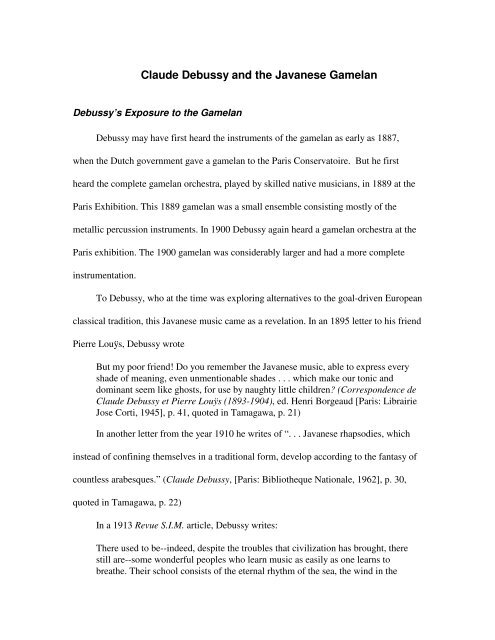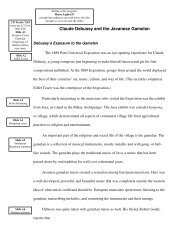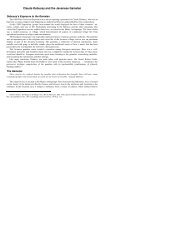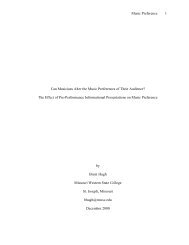Claude Debussy and the Javanese Gamelan
Claude Debussy and the Javanese Gamelan - Brent Hugh's
Claude Debussy and the Javanese Gamelan - Brent Hugh's
- No tags were found...
You also want an ePaper? Increase the reach of your titles
YUMPU automatically turns print PDFs into web optimized ePapers that Google loves.
<strong>Claude</strong> <strong>Debussy</strong> <strong>and</strong> <strong>the</strong> <strong>Javanese</strong> <strong>Gamelan</strong><br />
<strong>Debussy</strong>’s Exposure to <strong>the</strong> <strong>Gamelan</strong><br />
<strong>Debussy</strong> may have first heard <strong>the</strong> instruments of <strong>the</strong> gamelan as early as 1887,<br />
when <strong>the</strong> Dutch government gave a gamelan to <strong>the</strong> Paris Conservatoire. But he first<br />
heard <strong>the</strong> complete gamelan orchestra, played by skilled native musicians, in 1889 at <strong>the</strong><br />
Paris Exhibition. This 1889 gamelan was a small ensemble consisting mostly of <strong>the</strong><br />
metallic percussion instruments. In 1900 <strong>Debussy</strong> again heard a gamelan orchestra at <strong>the</strong><br />
Paris exhibition. The 1900 gamelan was considerably larger <strong>and</strong> had a more complete<br />
instrumentation.<br />
To <strong>Debussy</strong>, who at <strong>the</strong> time was exploring alternatives to <strong>the</strong> goal-driven European<br />
classical tradition, this <strong>Javanese</strong> music came as a revelation. In an 1895 letter to his friend<br />
Pierre Louÿs, <strong>Debussy</strong> wrote<br />
But my poor friend! Do you remember <strong>the</strong> <strong>Javanese</strong> music, able to express every<br />
shade of meaning, even unmentionable shades . . . which make our tonic <strong>and</strong><br />
dominant seem like ghosts, for use by naughty little children? (Correspondence de<br />
<strong>Claude</strong> <strong>Debussy</strong> et Pierre Louÿs (1893-1904), ed. Henri Borgeaud [Paris: Librairie<br />
Jose Corti, 1945], p. 41, quoted in Tamagawa, p. 21)<br />
In ano<strong>the</strong>r letter from <strong>the</strong> year 1910 he writes of “. . . <strong>Javanese</strong> rhapsodies, which<br />
instead of confining <strong>the</strong>mselves in a traditional form, develop according to <strong>the</strong> fantasy of<br />
countless arabesques.” (<strong>Claude</strong> <strong>Debussy</strong>, [Paris: Biblio<strong>the</strong>que Nationale, 1962], p. 30,<br />
quoted in Tamagawa, p. 22)<br />
In a 1913 Revue S.I.M. article, <strong>Debussy</strong> writes:<br />
There used to be--indeed, despite <strong>the</strong> troubles that civilization has brought, <strong>the</strong>re<br />
still are--some wonderful peoples who learn music as easily as one learns to<br />
brea<strong>the</strong>. Their school consists of <strong>the</strong> eternal rhythm of <strong>the</strong> sea, <strong>the</strong> wind in <strong>the</strong>
Photo credit: Flickr/Phil Norton<br />
About this working paper<br />
This New Climate Economy Working Paper was written as a supporting document for <strong>the</strong> 2015 report of <strong>the</strong> Global<br />
Commission on <strong>the</strong> Economy <strong>and</strong> Climate, Seizing <strong>the</strong> Global Opportunity: Partnerships for Better Growth <strong>and</strong> a Better Climate.<br />
It reflects <strong>the</strong> research conducted for Section 2.9 of <strong>the</strong> full report <strong>and</strong> is part of a series of 10 Working Papers. It reflects<br />
<strong>the</strong> recommendations made by <strong>the</strong> Global Commission.<br />
Citation<br />
Gençsü, I. <strong>and</strong> Hino, M., 2015. Raising Ambition to Reduce International Aviation <strong>and</strong> Maritime Emissions. Contributing paper<br />
for Seizing <strong>the</strong> Global Opportunity: Partnerships for Better Growth <strong>and</strong> a Better Climate. New Climate Economy, London <strong>and</strong><br />
Washington, DC. Available at: http://newclimateeconomy.report/misc/working-papers.<br />
New Climate Economy<br />
c/o World Resources Institute<br />
10 G St NE<br />
Suite 800<br />
Washington, DC 20002, USA<br />
+1 (202) 729-7600<br />
New Climate Economy<br />
c/o Overseas Development Institute<br />
203 Blackfriars Road<br />
London, SE1 8NJ, UK<br />
+44 (0) 20 7922 0300<br />
www.newclimateeconomy.report<br />
www.newclimateeconomy.net<br />
This work is licensed under <strong>the</strong> Creative Commons Attribution-NonCommercial-NoDerivative Works 3.0<br />
License. To view a copy of <strong>the</strong> license, visit https://creativecommons.org/licenses/by/3.0/us.<br />
2<br />
Raising Ambition to Reduce International Aviation <strong>and</strong> Maritime Emissions<br />
WWW.NEWCLIMATEECONOMY.NET
Brent Hugh, Page 3<br />
tunings used in gamelan music, or at least scales <strong>and</strong> tunings which are different<br />
from <strong>the</strong> major-minor system.<br />
4. Timbres <strong>and</strong> tone colors evocative of <strong>the</strong> gamelan. The resonating piano is<br />
perhaps Western music’s closest approximation of <strong>the</strong> sound of <strong>the</strong> gamelan. Soft,<br />
pedalled, staccato notes, soft seconds, low fifths held in <strong>the</strong> pedal, <strong>and</strong> high, fast,<br />
ostinato-type figures all suggest aspects of <strong>the</strong> gamelan’s timbre.<br />
5. Textures reminiscent of layered gamelan texture. The most characteristic texture<br />
is a low, slow-moving, sustained gong sound, overlaid by a moderately moving<br />
melody in <strong>the</strong> middle range of <strong>the</strong> piano, <strong>and</strong> faster-moving figures in <strong>the</strong> upper<br />
range of <strong>the</strong> piano.<br />
Tamagawa suggest that one or two of <strong>the</strong>se characteristics alone does not<br />
necessarily indicated <strong>the</strong> presence of gamelan influence. However, when most of <strong>the</strong>se<br />
factors are strongly present in a particular piece or section of music, it is a good indication<br />
of gamelan influence (Tamagawa, p. 32-35). Tamagawa claims that <strong>the</strong>se most of <strong>the</strong>se<br />
factors were present, at least occasionally <strong>and</strong> in isolation, in <strong>Debussy</strong>’s music prior to<br />
1890, but soon after 1890 <strong>the</strong> factors increase dramatically (Tamagawa, p. 35).<br />
Despite Tamagawa’s encyclopedic discussion of nearly every possible instance of<br />
gamelan influence in <strong>Debussy</strong>’s music, however, <strong>the</strong> dissertation is less than convincing<br />
on this point, perhaps because Tamagawa fails to contrast <strong>the</strong> non-gamelan influenced<br />
music with <strong>the</strong> gamelan-influenced music, <strong>and</strong> perhaps because <strong>the</strong> argument is spread<br />
over <strong>the</strong> course of a 152 document <strong>and</strong> never succinctly summarized.<br />
The purpose of this paper is to compare a group of pre-gamelan pieces with a group<br />
of post-gamelan pieces, rating <strong>the</strong>m according to Tamagawa’s five criteria, <strong>and</strong>
Brent Hugh, Page 4<br />
determining conclusively whe<strong>the</strong>r Tamagawa’s five factors increased after <strong>Debussy</strong>’s<br />
exposure to gamelan music.<br />
Four pieces were selected from 1890 or before, <strong>and</strong> four pieces from after 1890.<br />
Solo piano works were selected simply because <strong>the</strong> scores were easily available. The<br />
results of <strong>the</strong> analysis are presented in Table 1 <strong>and</strong> discussed in more detail below.<br />
Pre-<strong>Gamelan</strong> works<br />
Danse bohémienne<br />
Danse bohémienne, written when <strong>Debussy</strong> was 18 years old, displays no unusual<br />
characteristics. It is a straightforward piano work in ABA form with functional chord<br />
progressions <strong>and</strong> no unusual textures.<br />
Arabesque #1<br />
Arabesque #1 is again quite straightforward. The ABA form is unusual only in that<br />
it moves to <strong>the</strong> IV in <strong>the</strong> B section. Some modal harmony is evident, although functional<br />
harmony predominates. A layered 3 against 2 texture briefly appears as part of <strong>the</strong> main<br />
<strong>the</strong>me.<br />
Arabesque #2<br />
Arabesque #2 is again in ABA form, <strong>and</strong> again <strong>the</strong> B section moves to IV ra<strong>the</strong>r<br />
than <strong>the</strong> expected V. The characteristic rhythm, extended for 11 measures at <strong>the</strong><br />
beginning of <strong>the</strong> piece, <strong>and</strong> cropping up regularly throughout <strong>the</strong> rest, forms an ostinatolike<br />
effect. A two layered texture is prominent at <strong>the</strong> beginning <strong>and</strong> a three-layered texture<br />
appears just before <strong>the</strong> return to A.
Brent Hugh, Page 5<br />
Rêverie<br />
Rêverie begins with an ostinato in <strong>the</strong> left h<strong>and</strong>. The harmony is mostly functional<br />
<strong>and</strong> <strong>the</strong> form ABA. The B includes an instance of a pentatonic melody over a static pedal<br />
point lasting eight measures.<br />
Conclusion<br />
It is clear that a few of <strong>the</strong> gamelan factors appear from time to time in <strong>the</strong>se early<br />
works. However, <strong>the</strong>ir use is definitely occasional <strong>and</strong> not systematic.<br />
Post-gamelan Works<br />
Pour le piano- “Prelude”<br />
The “Prelude” from Pour le piano is <strong>the</strong> first striking instance of <strong>the</strong> use of gamelan<br />
effects in <strong>Debussy</strong>’s piano music. The toccata-like figurations often suggest layered<br />
textures similar to gamelan music. For instance, starting in m. 6 is a 32-measure-long A<br />
pedal point. Above this is a melody moving in quarter notes <strong>and</strong> above this, a fast<br />
figuration moving in 16th notes. The middle section evokes gamelan sonorities, too, with<br />
32 measures of trills (held in <strong>the</strong> pedal) overlaid with a slower melody, beginning in<br />
measure 59.<br />
The form, too, is strikingly different than <strong>the</strong> simple ABA forms previously<br />
encountered. When analyzed by motive, it is A'' B B A A' B' B A Coda. Overall, ABA<br />
form is suggested, because <strong>the</strong> BA motives return in exactly <strong>the</strong> same form each time,<br />
while <strong>the</strong> A'B' section (with <strong>the</strong> trills) has a developmental feel, <strong>and</strong> <strong>the</strong> six-measure long<br />
A'' is introductory <strong>and</strong> in fact has <strong>the</strong> same figuration as <strong>the</strong> B motive which follows
Brent Hugh, Page 6<br />
Tonally, <strong>the</strong> movement is striking as well, <strong>and</strong> closely approaches <strong>the</strong> idea of<br />
symmetrical, ra<strong>the</strong>r than functional, key relationships:<br />
Motive A'' B B A A' B' B A Coda<br />
Key center a a a C d-eb-e-f-f# ab a C a<br />
The dual a minor/C major center forms <strong>the</strong> basis which is returned to at <strong>the</strong> end,<br />
<strong>and</strong> middle section fills in <strong>the</strong> distance from C up to A.<br />
Unusual, too, in this tonal scheme, is <strong>the</strong> fact that <strong>the</strong> A motive remains in C major,<br />
never resolving into <strong>the</strong> a minor which concludes <strong>the</strong> work. This again suggests that <strong>the</strong><br />
tonality really is a duality of a minor/C major.<br />
Pour le piano-“Sarab<strong>and</strong>e”<br />
The “Sarab<strong>and</strong>e” from Pour le piano is a reminder that not all of <strong>Debussy</strong>’s music<br />
from <strong>the</strong> post-gamelan period used gamelan-inspired textures <strong>and</strong> techniques. The<br />
“Sarab<strong>and</strong>e” is in what some have called <strong>Debussy</strong>’s “ancient style,” with many chords<br />
moving in parallel <strong>and</strong> a definite modal flavor. The texture is mostly chordal, with little<br />
layering. The form is a simple ABA, although <strong>the</strong> tonal scheme is unusual:<br />
Section: A B A<br />
Key center: g# → c# c# → E → f# g# → c#<br />
“Pagodes”<br />
“Pagodes,” from Estampes is <strong>the</strong> most clearly influenced by gamelan music of any<br />
of <strong>Debussy</strong>’s piano works. Its pentatonicism--reminiscent of <strong>the</strong> slendro tuning--is more<br />
thoroughgoing than any of <strong>Debussy</strong>’s o<strong>the</strong>r piano works. Sections which use only four
Brent Hugh, Page 7<br />
notes of <strong>the</strong> pentatonic scale (for instance, mm. 37ff) are similar to gamelan pieces which<br />
mainly use four notes of <strong>the</strong> available five in slendro tuning. The evocations of gamelan<br />
timbre are more complete also, ranging from <strong>the</strong> suggestion of bells <strong>and</strong> gongs in <strong>the</strong> first<br />
two measures to many soft, pedaled staccatos, often in octaves, to cascades of 4ths <strong>and</strong><br />
5ths high on <strong>the</strong> keyboard. The main melody--which is exp<strong>and</strong>ed <strong>and</strong> developed in a<br />
manner suggestive of <strong>the</strong> nuclear melodies of gamelan music--is always presented in <strong>the</strong><br />
middle range of <strong>the</strong> piano, in <strong>the</strong> same range a gamelan’s nuclear melody would be heard.<br />
A layered texture is maintained throughout, <strong>and</strong> always in <strong>the</strong> configuration found in<br />
gamelan music, with low gongs sounding periodically, a moderately paced melody in <strong>the</strong><br />
middle, <strong>and</strong> faster moving figurations in <strong>the</strong> upper range.<br />
“Pagodes” evokes <strong>the</strong> cycles of gamelan music, which often end with a ritard<strong>and</strong>o<br />
leading into <strong>the</strong> solo gong beat which begins <strong>the</strong> following cycle. This arrangement is<br />
found in m. 4, 6, 8, <strong>and</strong> 10, for instance. “Pagodes,” more than most of <strong>Debussy</strong>’s works,<br />
suggests <strong>the</strong> rhythmic complexity <strong>and</strong> interplay among <strong>the</strong> various gamelan instruments,<br />
for instance in <strong>the</strong> 3 against 2 rhythms of mm. 21ff <strong>and</strong> in <strong>the</strong> more complex overlaid<br />
rhythms of mm. 37ff.<br />
All in all, “Pagodes” uses many more gamelan effects than any of <strong>Debussy</strong>’s o<strong>the</strong>r<br />
gamelan-influenced music. This suggests that <strong>Debussy</strong> was well aware of many o<strong>the</strong>r<br />
possibilities suggested by gamelan music. The five influences identified by Tamagawa<br />
<strong>and</strong> found throughout <strong>Debussy</strong>’s post-gamelan works--a subset of gamelan influences<br />
found in “Pagodes”--are not all <strong>the</strong> possible aspects of gamelan music which <strong>Debussy</strong><br />
could have imitated, but ra<strong>the</strong>r those aspects which resonated with his own proclivities,<br />
<strong>and</strong> which he made a permanent part of his own musical style.
Brent Hugh, Page 8<br />
L’isle joyeuse<br />
L’isle joyeuse is a fine example of music which is not intended to evoke an oriental<br />
or exotic context, yet which continually uses gamelan-inspired elements. Ostinato is used<br />
as a important structural component throughout <strong>the</strong> piece. Static ra<strong>the</strong>r than functional<br />
harmony prevails--for instance, a pedal A is continually renewed, with only small<br />
interruptions, for 92 measures beginning in m. 7. The form is made up of small episodes<br />
which blend into each o<strong>the</strong>r without a pause, <strong>and</strong> disappear <strong>and</strong> reappear without ever<br />
creating a discernible pattern of repetition. Whole tone <strong>and</strong> chromatic scales are<br />
interspersed with diatonic material. A layered texture is maintained throughout.<br />
Conclusion<br />
Table 2 summarizes all of <strong>Debussy</strong> solo piano music through 1903. Although <strong>the</strong><br />
analysis of <strong>the</strong>se works is not as detailed as were <strong>the</strong> analyses in Table 1, it points to <strong>the</strong><br />
same general conclusion as did <strong>the</strong> more detailed analyses: The five elements of gamelan<br />
influence were occasionally <strong>and</strong> weakly evident before 1890, but become much stronger<br />
<strong>and</strong> are evident in a much higher percentage of <strong>Debussy</strong>’s works after 1890. This is<br />
strong evidence that <strong>Debussy</strong> was, in fact, powerfully influenced by his exposure to<br />
gamelan music.<br />
It is clear as well that, except in a few isolated cases, <strong>Debussy</strong> was not trying to<br />
simply transfer gamelan music into a western form, nor was he using specific motives or<br />
melodies from gamelan music. Ra<strong>the</strong>r, <strong>Debussy</strong> selected few of <strong>the</strong> procedures, ideas, <strong>and</strong><br />
sounds found in gamelan music that resonated with his own aes<strong>the</strong>tic sensibilities <strong>and</strong><br />
which found a place in his repertoire of compositional devices <strong>and</strong> ideals.
Brent Hugh, Page 9<br />
Why a delay in <strong>the</strong> Gamalan influence? (<strong>Debussy</strong> heard <strong>Gamelan</strong> 1889, still<br />
composed music apparently not inspired by gamelan music in 1890) Possibly because<br />
some of <strong>the</strong> 1890 compositions were written, or at least gestated, before <strong>the</strong> exposure to<br />
gamelan music (Tamagawa suggests this). But also, even more probably, because<br />
<strong>Debussy</strong>’s use of <strong>the</strong> gamelan technique was not simple imitation or wholesale<br />
borrowing, but ra<strong>the</strong>r a process of assimilation <strong>and</strong> of making <strong>the</strong> ideas <strong>and</strong> sounds<br />
prominent in gamelan music a part of his own way of making music <strong>and</strong> expressing<br />
himself. This process of assimilation is shown in <strong>the</strong> history of <strong>the</strong> Fantasie for piano <strong>and</strong><br />
orchestra, <strong>the</strong> earliest music <strong>Debussy</strong> wrote under <strong>the</strong> influence of gamelan sound. The<br />
Fantasie is <strong>the</strong> only of <strong>Debussy</strong>’s compositions to directly use gamelan motives. Despite<br />
<strong>the</strong> use of <strong>the</strong>se motives <strong>and</strong> a few gamelan-inspired techniques as well, <strong>the</strong> gamelan<br />
influence on Fantasie is a thin veneer. Functional harmony <strong>and</strong> form predominate (ex.).<br />
Within a short time (date?), <strong>Debussy</strong> realized that this was not <strong>the</strong> way to use <strong>the</strong> gamelan<br />
techniques. He withdrew <strong>the</strong> Fantasie, reportedly for exactly that reason—he was<br />
displeased with <strong>the</strong> way gamelan techniques were addressed (cite). The withdrawal of<br />
Fantasie represents a shift in <strong>Debussy</strong>’s thinking, <strong>and</strong> a signal that he was incorporating<br />
<strong>the</strong> gamelan ideals into <strong>the</strong> fabric of his compositional thought in a much deeper <strong>and</strong><br />
more fundamental way. It is from <strong>the</strong> date of this withdrawal of Fantasie, <strong>and</strong> not from<br />
1889, <strong>the</strong> date of mere exposure to gamelan music, that<br />
One question remains: Could <strong>the</strong>se factors have arisen from o<strong>the</strong>r influences than<br />
gamelan music? Undoubtedly, <strong>Debussy</strong> learned of many of <strong>the</strong>se elements in o<strong>the</strong>r<br />
contexts. For instance, he heard pentatonic <strong>and</strong> whole tone scales during his visits to<br />
Russia. Static harmony, extended pedal points, <strong>and</strong> pentatonicism were aspects of Grieg’s
Brent Hugh, Page 10<br />
music which <strong>Debussy</strong> knew well (Tamagawa, p. 42-43). But to <strong>the</strong>se ra<strong>the</strong>r isolated <strong>and</strong><br />
experimental examples of <strong>the</strong>se techniques, <strong>Debussy</strong>’s experience with gamelan music<br />
brought something unique: exposure to a well-developed <strong>and</strong> complete system of musicmaking,<br />
capable of powerfully expressing a wide variety of moods <strong>and</strong> emotions, which<br />
made continual use of <strong>the</strong>se ideas as important structural elements. Seeing <strong>the</strong>se<br />
elements--ostinato, static harmony, symmetrical forms, exotic scales, unusual timbres,<br />
<strong>and</strong> layered textures--used as important elements of a complete system is what sets<br />
gamelan influence apart <strong>and</strong> makes it arguably much more important to <strong>Debussy</strong>’s<br />
development than o<strong>the</strong>r, isolated, examples of exposure to <strong>the</strong>se elements. Finding <strong>the</strong>se<br />
ideas embedded in a well-developed system of music ignited <strong>Debussy</strong>’s imagination <strong>and</strong><br />
inspired him to make <strong>the</strong>m work in his own music.
Brent Hugh, Page 11<br />
Bibliography<br />
Harpole, Patricia W. “<strong>Debussy</strong> <strong>and</strong> <strong>the</strong> <strong>Javanese</strong> <strong>Gamelan</strong>.” American Music<br />
Teacher, 35, no. 3 (Jan 1986), 8-9, 41.<br />
Roberts, Paul. Images: The Piano Music of <strong>Claude</strong> <strong>Debussy</strong>. Portl<strong>and</strong>, Oregon:<br />
Amadeus Press, 1996.<br />
Tamagawa, Kiyoshi. Echoes From <strong>the</strong> East: The <strong>Javanese</strong> <strong>Gamelan</strong> <strong>and</strong> its<br />
Influence on <strong>the</strong> Music of <strong>Claude</strong> <strong>Debussy</strong>. D.M.A. document. The University of Texas at<br />
Austin (1988).
<strong>Claude</strong> <strong>Debussy</strong><br />
<strong>and</strong> <strong>the</strong><br />
<strong>Javanese</strong> <strong>Gamelan</strong><br />
by<br />
Brent Hugh<br />
3 May 1997





